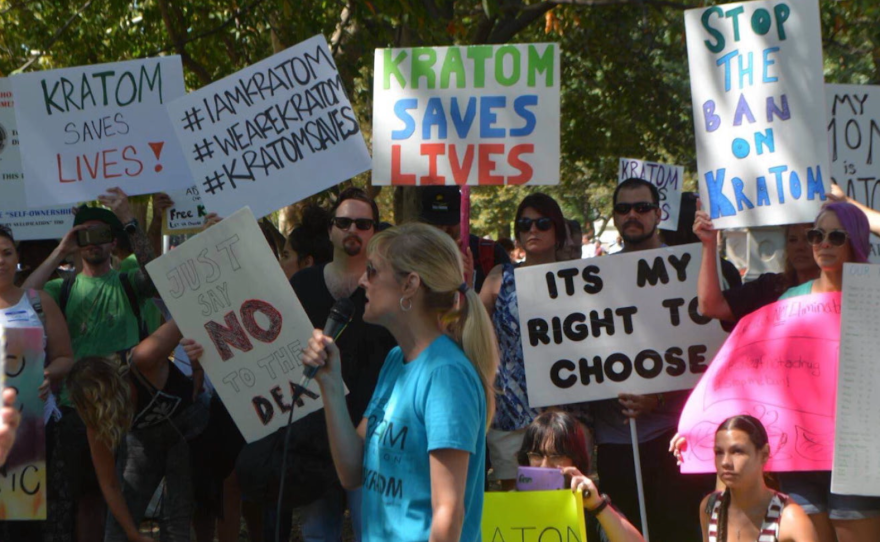dangerous drug or healing herb. It is called kraton the drug enforcement had set their sights on banning it nationwide looking into the reasons why and what it could mean for the people who use it to manage pain Vicodin and OxyContin and tramadol. Erin Walker lists medications he wants use more pain. The most recent prescription was something like 300 pills and I was supposed to take 43 times per day. He says prescriptions works for a while for his herniated discs and sciatica but not always ask we got to the stuff, what do you do? They continue to medicate you because you are in pain. He started seeking alternative treatments for his name. He found his answer and a botanical. I feel awesome it's great. What is this stuff. It's awesome yes it's called Kratom a plant grown in Southeast Asia used for centuries in the region to treat fatigue, pain, anxiety. The plant leaves are dried powder mailed and can be consumed in different ways he compares the sensation to wrapping himself and a warm blanket. When it washes over you you feel energized and relaxed and you feel the pain while -- melt away and everything's okay. Kratom has two main compounds seven hydroxy Medrad simulating receptors like opiates. Some former opiate users say it can mitigate withdrawal system -- symptoms but the Drug Enforcement Administration says Kratom needs to be regulated on August 31 they filed an emergency action to make Kratom schedule one substance, category reserved for the most dangerous drugs , DEA special agent Amy Roderick says Kratom is considered a danger to public health. That's what we found here. We decided this was enough of a threat that people were getting addicted that we needed to schedule. Following a DEA notice nationwide ban takes 30 days to go into effect. I lost my cell because the medicine chest Kratom committee used the time to hold rally starting as they Kratom online movement and collected over 140,000 signatures including from 51 members of Congress and 11 senators. Don't take away. DEA withdrew the notice of intent and open the public comment period Echols is December 2 -- that closes December 2 they can follow through with the emergency then or wait for more signs on the substance transports Amy Roderick. Leslie came back from the FDA makes a way, this cures cancer. Then we can we move it down to a lower schedule, schedule 2, three, four, five were other drugs are. Country is legal including California. It was recently banned in the city of San Diego when it was included in an ordinance passed that also been synthetics used to make spice and bath salts. Mitragynine and 7-hydroxymitragynine the main alkaloids in Kratom were on the itemized list. The city of Temecula drafted a similar ordinance and City Council was ready to vote on the measure. Erin Walker spoke at the meeting. Good evening. I took some this evening. I am not hallucinating, I am not running around, I am not aggressive or crazy. This is something that I take because I have a back issue. Mayhem McGarr. I don't know anything about Kratom to be honest with you because I don't know about it time hesitant to go to ban it. Kratom band was voted down a small victory for Kratom consumer tax anything that can cause dependence is potentially harmful. Dr. Richard Clark head of toxicology at you with the medical center. To me that is probably the most aspect of this that if we made it more available people would use it like an opiate, overuse it like an opiate become dependent on it like they do with the opiate and have to go through withdrawal or not be able to stop it. Some people report withdrawal from Kratom uses as easy as getting off caffeine. Others say withdrawal can bring panic attacks and excessive sweating on addiction and recovery website a blog or says Kratom is as addictive as Vicodin and Adderall and called it the indisputable king of misery. After experiencing the pain relieving benefits of Kratom, Erin Walker joined the United Kratom Association as an advocate and now sells a product for an online distributor . He says if it does become illegal in the U.S., he will continue to find a way to use it. If Kratom is banned I will continue using it. Absolutely. Not go back to prescriptions? No, Wanda. Meyer troubles the KPBS news.
A plant called kratom has been used for centuries in Southeast Asia to treat fatigue, pain and anxiety. But it has sparked controversy in the United States.
The Drug Enforcement Administration says kratom is dangerous and wants to classify it as a Schedule 1 drug, making it illegal to manufacture, sell or possess with intent to sell.
North Park resident Aaron Walker does not want to see the drug become classified as a controlled substance. After years of filling prescriptions for pain medication, Walker discovered kratom to treat pain from herniated discs and sciatica while on deployment in the Navy.
“I don’t feel my pain at all. I feel awesome,” Walker said. “This is great. This is awesome!“
The leaves of the plant are dried and milled in to a powder, which can be consumed in different ways. Walker used to mix the powder into chocolate milk to mask the bitterness, but now he takes it with orange juice.
Walker compares the sensation he feels from taking kratom to wrapping himself in a warm blanket.
“When it washes over you, you feel energized, you feel relaxed, you feel the pain kind of melt away and everything’s OK,” he said.
Kratom has two main compounds — mitragynine and 7-hydroxymitragynine — that stimulate receptors in the brain like opiates.
On Aug. 31, 2016, the DEA filed an emergency action to make kratom a Schedule I substance, a category reserved for the most dangerous drugs.
DEA Special Agent Amy Roderick said kratom is considered a danger to public health with no known medical benefits.
“We have to be able to put things on emergency scheduling system to protect the community. And that’s what we found here. We decided this was enough of a threat and people were getting addicted that we needed to schedule it,” Roderick said.
Following a DEA notice, a nationwide ban takes 30 days to go into effect.
The kratom community appealed to the DEA to delay their decision. They held rallies and started a "save kratom" online movement. They collected over 140,000 signatures, including from 51 members of Congress and 11 U.S. Senators.
The DEA has since withdrawn its notice of intent and opened a public comment period that closes on Dec. 2.

Then the DEA can either follow through with its emergency ban on kratom for a minimum of two years, or it can wait for more science on the substance.
“Let's say something came back from the FDA and they said, ‘Hey wait a minute, this cures cancer.’ Then we could remove it down to a lower schedule — Schedule 2,3,4,5 — where all the prescription drugs are,” Roderick said.
Kratom is still legal in most states, including California. It was recently banned in the city of San Diego when it was included in an ordinance that also banned synthetics used to make Spice and Bath Salts. Mitragynine and 7-hydroxymitragine, the main alkaloids in kratom, were on the itemized list.
“I believe this ordinance is going to be a model for other cities to follow and help set the standard throughout the state,” Mayor Kevin Faulconer said.
The city of Temecula drafted a similar ordinance and the city council voted it down. It was a small victory for kratom consumers.
But Roderick said self-medicating with an unregulated substance is not the solution to pain.
“It just doesn’t seem worth it to me. If you’re in pain, you should go to the doctor and deal with it that way," Roderick said. "This is an addictive substance just like any other drug and when you start putting these things into your body you’re going to become addicted. I know people who say, ‘Oh it helps opioid addiction.’ But in and of itself, it is an opioid.”
Dr. Richard Clark, head of toxicology at UC San Diego Medical Center, said anything that can cause dependence is potentially harmful.
“To me that’s probably the most dangerous aspect of this, and if we made it more available that people would use it like an opiate, overuse it like an opiate, become dependent on it like they do with an opiate, and then have to go through withdrawal or not be able to stop it,” Clark said.
Some people report withdrawal from kratom use is as easy as getting off caffeine. Others say withdrawal can bring panic attacks and excessive sweating.
Clark said he doesn’t think people know how this drug really works.
“I think that from a pure science perspective, pure potential perspective, this drug has potential and I think that if there is something about this compound that gives you pain relief without the respiratory depressant affects that we see with they other opiates, that would be a breakthrough,” Clark said. “There’s clearly not enough science to know that yet.”
But the science is catching up. Drug companies are aggressively searching for a non-addictive pain medication that doesn’t make you stop breathing, which is the leading cause of death in opiate abuse. One promising compound is mitragynine from kratom.
Kratom advocates support the study because they say it will save lives but find the timing curious.
“Well, oh my gosh here comes a new patented drug, Schedule 2, right on the market, and we will prescribe it to you and it will help with your opiate withdrawals that we caused in the first place,” Walker said.

“Finding that drug,” said Clark, “which will be a Nobel-prize winning drug that helps you with opiate receptors and doesn’t have either tolerance, dependence, or withdrawal and doesn’t make you stop breathing — that somebody is going to make a lot of money off one day.”
When asked if it could be kratom, Clark said it’s possible.
After experiencing the pain-relieving benefits of kratom, Walker joined the United Kratom Association as an advocate and now sells the product for an online distributor.
If kratom does become illegal in the U.S., some kratom consumers worry they will relapse on their drug of choice or, like Walker, continue to find a way to use it.
“If kratom is banned I will continue using it, absolutely,” Walker said.
Asked if he would ever go back to prescription pain medication, Walker responded, “Nope. No, won’t do it.”







